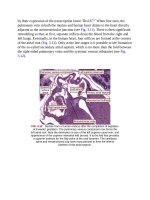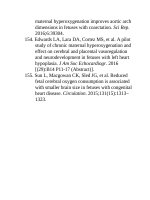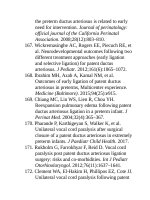Andersons pediatric cardiology 1062
Bạn đang xem bản rút gọn của tài liệu. Xem và tải ngay bản đầy đủ của tài liệu tại đây (122.78 KB, 3 trang )
intheheartshownatleft,whereastheheartatrightshowsamousewith
pulmonarydominanceandinterruptionoftheaorticarch.
DiagnosticFeatures
AntenatalDiagnosis
Itmightbeexpectedthatcommonarterialtrunkwouldbedetectedduringthe
mid-trimesterscanforfetalanomalies,whichisroutineinmanycountries.In
practice,population-basedstudiesdemonstratethatthediagnosismayoftenbe
missed,19,20presumablybecausethefour-chamberviewoftheheartmayappear
tobenormalonsuperficialexamination.Nonetheless,moredetailed
examinationofthefetalheartshouldrevealaventricularseptaldefect.An
arterialtrunkthatoverridesthedefectistheonlyoutletthatarisesfromthe
ventricularmass.21Itshouldbepossibletodocumentthedegreeofregurgitation
orstenosisofthetruncalvalve,andthecourseandintegrityoftheaorticarch
(Table40.1).22Oneparticularchallengeintheantenatalexaminationoffetuses
inwhomonlyasinglearterialtrunkarisesfromthehearthasbeenin
distinguishingthosewithcommonarterialtrunkfromthosewithtetralogyof
Fallotwithpulmonaryatresia,althoughusingcurrenttechnologies,including
four-dimensionalspatiotemporalimagecorrelationechocardiography,this
distinctioncanbeachievedinmostcases.23
Table40.1
KeyDiagnosticFeaturesinCommonArterialTrunk
DiagnosticMethod
Fetalechocardiogram
Four-chamberview
Greatvessels
Aorticarch
Clinicalexamination
Inspection
Palpation
Auscultation
Electrocardiogram
Features
Ventricularseptaldefectwithtruncaloverride(mayappearnormal)
Singlearterialtrunk
Truncalregurgitation
Interruption
(?)Mildcyanosis
Failuretothrive
Tachypnea
Boundingpulses
Liverenlargement
Normalfirstheartsound
Mayhaveasinglesecondsound(althoughnotalways)
Ejectionclick
Ejectionsystolicmurmur
(?)Diastolicmurmuroftruncalregurgitation
Nonspecificusuallycombinedventricularhypertrophy
Chestradiograph
Echocardiogram
Parasternallongaxis
Parasternalshortaxis
Apicalfourchamber
Highparasternal
Cardiaccatheterization
Hemodynamics
Oximetry
Pulmonaryvasodilator
Angiocardiography
Cardiomegaly
Increasedpulmonaryvascularmarkings
Narrowarterialpedicle
Truncalorigin
Ventricularsizeandmuralthickness
Ventricularseptaldefect
Velocityofinterventricularshunting
Truncalregurgitation
Morphologyoftruncalvalve
Mechanismoftruncalregurgitation
Originofpulmonaryarteries
Stenosisofpulmonaryarteries
Originofcoronaryarteries
Ventricularoriginoftrunk
Truncalregurgitation
Truncalstenosis
Functionofatrioventricularvalves
Aorticarch
Arterialduct
Interruptionofaorticarch
Pressuremeasurementinrightandleftpulmonaryarteries
Pressuredropacrosstruncalvalve
Pulmonary-to-systemicbloodflowratio
Toassesspulmonaryvascularresponsiveness
Truncalinjectiontoexaminethedegreeofregurgitation
Selectivepulmonaryangiogram
Leftventriculogramtoevaluatethesizeandlocationofseptaldefects
Asignificantproportionoffetuseswillhaveassociatednoncardiac
anomalies,24withorwithoutadeletioninchromosome22.25
NeonatalPresentation
Thetypicalpatientwillpresentduringtheneonatalperiod,orinearlyinfancy,
withmildcentralcyanosis,ahyperactiveprecordium,andsignsofincreasing
congestivecardiacfailure.Therewillbedifficultiesinfeeding,failuretothrive,
tachypnea,andhepaticenlargement.Althoughaminordegreeofhypoxemiais
common,obviouscyanosisisafeatureofeitherraisedpulmonaryvascular
resistanceorpulmonarystenosis.Oncecardiacfailureisestablished,thechest
maybulgeinconsequenceofthecardiomegaly.
Atauscultation,thefirstheartsoundisusuallynormal,whereasthesecond
soundisaccentuated.Althoughitmightbeanticipatedthatthesecondsound
wouldalwaysbesingleinthepresenceofacommonarterialvalve,thereis
splittingofthesecondsoundinapproximatelyone-halfofinfants,documented
byphonocardiographyandbyauscultation.26Possibleexplanationsforthisare









